Advanced Audience Targeting for Remarketing #SMX was originally published on BruceClay.com, home of expert search engine optimization tips.
If you can do precise audience targeting, you can have more control over who sees your ads — and get more conversions for your marketing buck! In this in-depth SMX West 2016 session, we’ll find out how to use advanced targeting techniques like remarketing lists, custom affinity lists, YouTube remarketing and more. The goal is to maximize your ad campaign ROI.
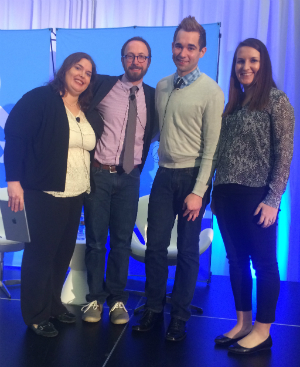
(From left) Pamela Parker of Search Engine Land with speakers Joe Kerschbaum, Mark Irvine and Amy Bishop
Moderator:
Pamela Parker, Contributing Editor, Search Engine Land (@pamelaparker)
Speakers:
- Mark Irvine, Sr. Data Scientist at WordStream (@MarkIrvine89)
- Joseph Kerschbaum, Account Director at 3Q Digital (@joekerschbaum)
- Amy Bishop, Director: Audits, Outbound, Training at Clix Marketing (@hoffman8)
Mark Irvine: 4 Ways to Find the Audience of Your Wildest Dream — & How to Convert Them!
Mark Irvine is a data scientist who researches industry trends in PPC. Dating is a lot like audience targeting. More of us are doing it online. It can be hard to find someone interested in you. Sometimes you’re going to stalk them (just a little bit). Your first impressions mean everything. It’s too easy to lose a good fit by not following through. He suggests approaching digital marketing like a courtship.
#1: Finding Someone New
Finding your ideal match is a journey. You don’t always know what you’re looking for right away. Rethink your key audiences. 40% of baby product purchasers live in households without children! Use Google Analytics to re-think the key audiences for your campaigns. He puts up a slide showing the conversion rate per in-market segment (found by opening Audience > Interests > Affinity Categories in GA). which helps you identify the key, most profitable demographics for your campaigns.
#2: The Chase
Chase past visitors with remarketing. Remarketing is going to reengage your best visitors. Highly engaged users are more likely to later convert. Remarketing is not just for display anymore! The same trends of conversion for engaged users are true across platforms, and users are 76 percent more likely to click on a remarketing ad! Google Customer Match boasts some of the best conversion rates in the industry.
(Note: Another WordStream speaker delved into Customer Match earlier this week; you can read Cleo Hage’s session liveblog for more on that.)
#3: The First Date
Choose where to court your audience. Couple relevant audiences with relevant website targets to boast positive engagement. Find your content match. Look to GA to find top referral placements — these will also be your top ad placements.
Get off mobile and app ads, though. Nearly half of all in-app ad clicks were found to be accidental. Typically we see mobile apps ad placements with a high CTR but disappointing conversion rate. Disclude your ads from in-app placement.
#4: Break the Dumb Rules
Don’t limit yourself with short membership duration or impression caps. This happens because it’s an industry best practice to set low impression caps to prevent annoying users. But actions speak louder than words. Users are more likely to click on remarketing ads when they’ve seen it 4, 5 or 6 times. Impression caps can hurt more than help, and ads are almost never served to their full impression cap. (He gives a few examples: a daily impression cap of 2 is delivered an average of 1.21 times; a cap of 3 gets an average of 1.54 impressions; 4 averages 1.75 impressions; etc.) Ad exposure increases CVR.
Give people time. Use your GA Time Lag Report to determine how long users wait before they buy. Set your membership duration to include 95 percent of your sales. Nurture people who are legitimately in your sales funnel even if you’re not sure what the time period should be.
Recap
- Use Google Analytics to find new audiences and demographics.
- Remarket to your best-converting audiences.
- Identify the best relevant content to pair with your audiences.
- Stay persistent with your best converting audiences! Avoid restrictive frequency caps and membership durations.
Amy Bishop: Best Practices for Audience Targeting in Remarketing
Before we can talk about audiences, we first have to talk about the goal of the campaign. Because remarketing is not a goal, even though successful remarketing is helpful. Think of what problem you’re solving, what you have that they need or want. This will help you define your audience.
Remarketing goals
- Keeping consumers engaged throughout a long buying cycle
- Closing the sale
- Bringing back previous buyers
- Prospecting (lookalikes)
- Announcing new products
- Re-engaging consumers with accessories or add-ons
Remarketing lists for search ads:
- Bid up valuable lists within search campaigns
- Exclude lists from non-RLSA
- Typically have lower CPCs and CPAs than non-RLSA campaigns.
The funny thing is this is a lower funnel audience, but we’re paying less for them.
Remarketing lists for shopping ads are similar to RLSA but for Shopping.
Remarketing for Dynamic Search Ads — RDSA is great for query mining with a safety.
Social remarketing is another push channel:
- Great for the mobile reach
- A lot of different ad formats
- Great for prospecting
- Social engagement can help provide trust and expand reach and Lookalike Audiences.
Audiences
Now you have your goals and your channel. It’s time to talk about the audience you want to achieve those goals.
Out with the old: Remarketing to everyone who hits the home page is out. Build informed remarketing lists using information you can gather from:
- Pages visited
- Source/medium/campaign information
- Actions taken on site (events, goals, conversions)
- Location
- Demographics
Example lists:
- Loyalists (via email, or UI login)
- Completed a micro-conversion
- Visited a page that speaks to their needs (product, industry)
- Remarketing lists for channels that don’t offer remarketing
- Hyperlocal lists
- Layering lists for specificity
- Seasonal or recurring needs
- Leads that haven’t closed
If they’ve visited a page that speaks to their needs, hit them with another page, product or industry, that also speaks to that need. Layer lists for specificity.
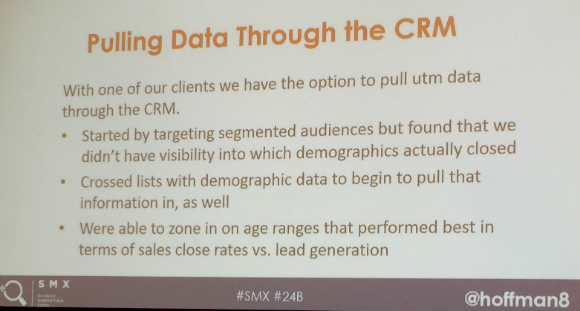
They created lists for demographics, crossed them with segmented lists, and were able to zone in on age ranges that performed best.
You might be thinking, OK, segmented lists perform better but there’s still a lot of volume coming from other lists that aren’t segmented. So, break out segmented lists as much as you can and create a catch-all campaign that excludes the segmented list. If your catch-all is bigger than your segmented lists, you may want to capture more information. The end goal is the primary conversion, but it shouldn’t be all or nothing for data collection. What can you get from them the first time they visit your site so you can deliver the right creative and product to them in remarketing?
Example funnel:
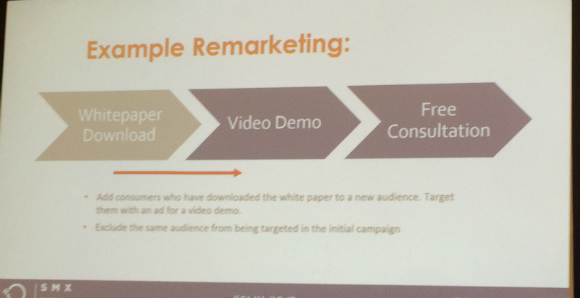
Remarketing ads should be helpful. Align messaging with consumer needs and interests, such as:
- Product or category they viewed
- Seasonal promotion, product, service or event
- New products
- Accessories for things they have purchased
- Sale or promotion
You’re trying to be helpful and useful and facilitating the conversion from your end. So customize ads and landing pages based on the info you’ve used to create your lists. The more you know, the better you can deliver.
When to make exclusions? Sometimes your audience isn’t what they seem. Not everyone will buy no matter how many times you remarket. So they will build audiences with the sole purpose of exclusions.
As an example, they built a remarketing list targeting visitors of a page. Though CPC was somewhat high, lead volume was also high. They excluded visitors that spent less than 5 seconds on the site (to cut spend on uninterested consumers). The results? They noted a 50.3 percent decrease in CPA, from $84.61 to $42.51.
Previous purchasers shouldn’t always be excluded.
Joseph Kerschbaum: Targeting an Audience That’s Never Visited Your Site, i.e., Magic
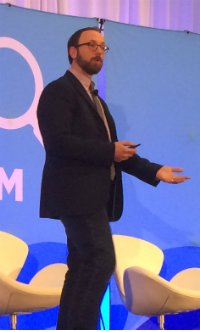
Joe Kerschbaum at SMX West
How do you get email addresses? Second-party data exchanges, co-sponsorships with other places. You get these emails and you put them in your remarketing list and start encouraging them. Customer Match freed your email lists and gave them room to breathe.
Now you can segment audiences in your CRM, including people who have never been to your website as well as previous customers, lost customers, etc. (see slide below).
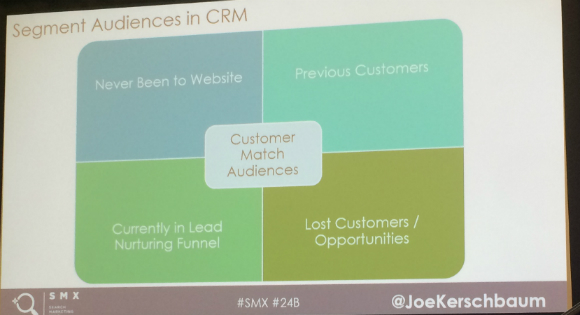
Where your Customer Match ads appear: Google search, YouTube and Gmail. Here are his points on uploading your email lists into AdWords:
- Upload first-party data in AdWords as an audience list. Lists are uploaded via a privacy-safe, hashed method.
- AdWords matches your email addresses to Google accounts (and then discards all data).
- You target or exclude your new audience list across devices and channels. This can improve the reach of your search, Gmail and YouTube campaigns.
- AdWords generates “Similar Audience” lists from original email lists when eligible (only available for Gmail and YouTube).
He sees good match rates, as we see in this data from WordStream:
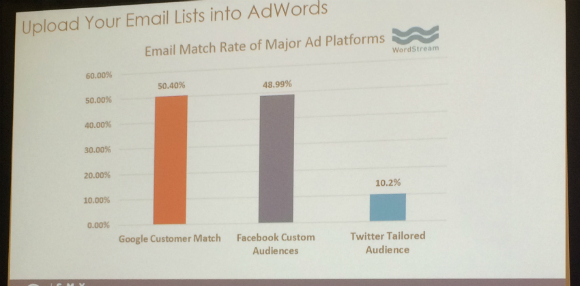
There’s a magic potion made from these tasks (ingredients):
- Pull email list from your CRM.
- Define audience segments before uploading.
- Upload list into AdWords and create audience.
- Create separate campaign for these targets.
Now you’re suddenly targeting people who have never been to your website.
Here’s another magical feat, getting a repeat app user.
Typically app download = success! But sometimes you put in all that effort in getting an app download and then open an account in the app and then never come back. Then your app is like a ghost town. So, there’s a way in AdWords to remarketing to people who have been to your app.
App Remarketing Process
Remarket to your app users. Promote sales, feature updates or your company’s other apps. Here’s a flow chart:
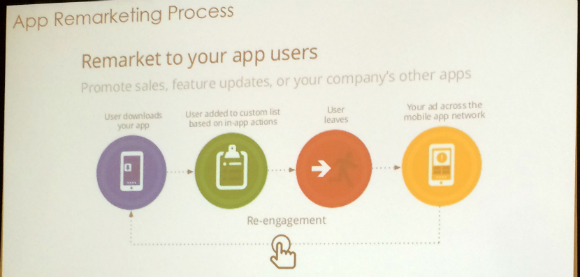
There is just a bit of code that has to be added to the app. Don’t cry. There is help in Google Developers! The article is “Mobile Apps Conversion Tracking and Remarketing.”
Kerschbaum’s “magic potion” ingredients for app remarketing are:
- Have a solid user base for your app.
- Integrate additional tagging into your app.
- Create RMKT audiences for mobile app users.
- Create new campaigns for app RMKT.
Similar Audiences
Google’s contextual engine monitors browsing activity on Display Network sites over the last 30 days and determines other users with similar behavior. If you segment your audiences, Google creates a similar audience for you. Voila!
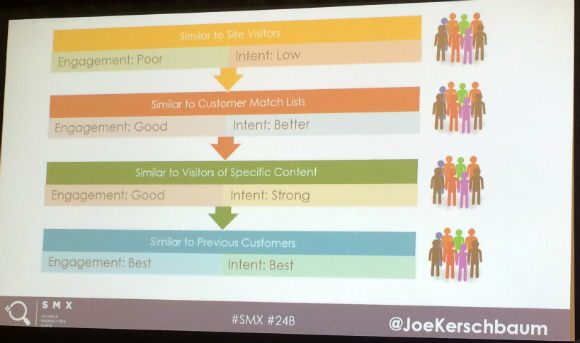
With Similar Audiences, conversion rates are right around the same as other remarketing, so there’s your trick for more volume.
YouTube
The YouTube ecosystem is huge:
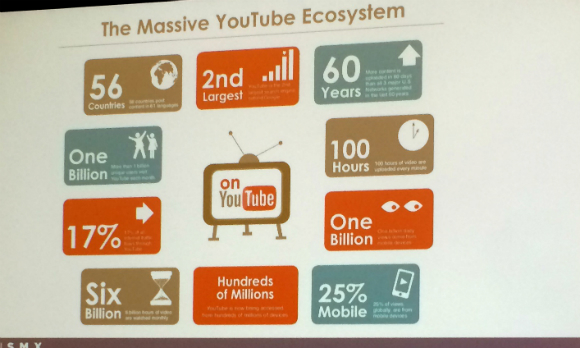
YouTube is getting more competitive, and your competition is going to be there if it’s not already. What are folks watching? The most active industries on YouTube are media, B2C technology, B2B technology, automotive, apparel, fast-moving consumer goods, food and beverage …
Looking at funnel position on YouTube by social network, and it shows that YouTube doesn’t close very well. It’s an introducing channel. You should see YouTube as a first-click attributor. Embrace the intent.
Remarket to YouTube viewers based on:
- People who watch any of your videos
- People who take an action on any of your videos
- People who view your video as a TrueView in-stream video ad
- People who visit or subscribe to your YouTube channel
To create your video RMKT lists, you can target anyone who viewed a video or viewed an ad. A lot of marketers using video are only posting 1–10 videos a year. Here are kinds of video creative content styles your organization might use:
- Live action or on-location (70% fall into this category)
- Testimonials or executive interviews (53%)
- Combination of styles (45%)
- Motion graphic 2D or 3D (42%)
- Stock images or footage (40%)
- Moving images or slide presentations (38%)
- Animated explainers (27%)
- Spokesperson or paid actor (26%)
- Other (4%)
Everyone has the same restrictions — limited budget and time. But everyone’s facing the same challenges.
Here’s the “magic potion” task list for YouTube remarketing:
- Link YouTube to your AdWords account.
- Launch TruView campaigns.
- Create RMKT audiences from YouTube viewers.
- Allow audiences to grow in size.
- Target YouTube audiences with RMKT.
- Exclude customers/converters.
- Exclude mobile devices.
No comments:
Post a Comment